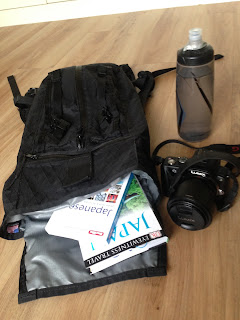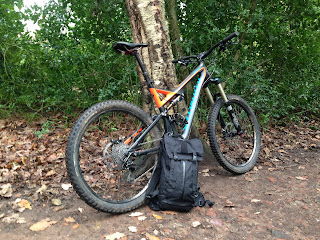I bought my Hauser back in January. For the full low down check my previous post here, but in summary I'd had my eye on Acre and its parent company Mission Workshop for a while and eventually bit the bullet and bought the 14litre Hauser to use both as a mountain bike hydration pack and a day pack / everyday carry. So how has this all American, Californian got on in a slightly wetter, muddier Sheffield.
The Hauser is designed and marketed squarely as a mountain bike backpack for use on the trails. That's great but at £175 I need my bags to do more. In the last 12 months it's been used for work, to carry groceries and as every day carry on a three week tour of Japan. It's been used on walks, buses, planes and obviously bikes and overall I've loved it.
It's subtle, yet stylish, small enough to be used every day but big enough to carry work essentials. I'd also be lying if I said the exclusivity wasn't a minor plus point. In the year I've been using the Hauser I'm yet to see another one.
Yet is it as good as it price tag might suggest.
So the positives and there's plenty of them.
Build quality
First up has to be build quality, after a year of tough use the Hauser still looks as good as it did on day one. No snags, no wear marks, no sign that this backpack has had some serious action.
The internal lining doesn't have any marks on it either and even on the bottom of the pack where it's constantly getting put down there are no abrasion marks. So it's definitely tough.
 |
| No scuffing to see here |
The ripstop nylon's diamond pattern gives a classy look and is easy to wipe clean. Living in northern England rain is a constant threat and so one thing I do insist on is a bag that can live up to the elements. I'm happy to say I've had no problems with the Hauser. Even in heavy snow and torrential rain the contents has stayed dry at all times.
Features
One of the best features has to be the tool roll. It slots in to the front pocket perfectly and negates the need for lots of pockets for pumps, inner tubes etc. It also means you can swap essential maintenance equipment quickly between bags.
 |
| My tool roll with a few of the commuter essentials |
Out on the trail it also means you've got somewhere to put tools and parts while you fix your bike. One point to consider though, if you aren't carrying a lot in the main compartment a heavy tool roll in the outer pocket can shift the weight balance slightly and pull the bag out of shape. Simple solution, put the tool roll in the main compartment when you're not carrying much.
The top closes in two ways. It simply folds over and fastens with two clasps or you can roll the top over and use a velcro strap to fasten it down. Initially I was concerned about the velcro but it still looks fresh and works perfectly after a year.
An internal pocket in the main compartment wouldn't have gone a miss but the small side pocket is really handy and easily accessed for phones and wallets.
 |
| The side pocket is perfect for easy access to phone and wallet |
Comfort
Early on I found the Hauser's shoulder straps to be quite light weight. On occasions I found it uncomfortable on the shoulders / neck when I was carrying heavier loads. However using the sternum strap (not something I always do) solved this and generally it's been a very comfortable backpack.
I also removed the waist belt as this I didn't feel it was necessary. The belt is a simple webbing strap and really just serves to stop the pack moving about rather than supporting any of the weight. Occasionally on steep and rocky drops the bag has moved about but generally I've found the Sternum strap plenty to hold it in place and the waist strap is folded up in the tool roll, just in case.
Versatility
The Hauser comes in two sizes, 10 and 14 litre. I chose the bigger of the two and I'm glad I did. As a daily carry the Hauser was perfect size for carrying all the necessities to work while not feeling too big when carrying lighter loads.
On day trips around Japan it easily took the daily essentials (camera, jacket, water, etc) while never screaming tourist or attracting attention.
 |
| The Hauser ready for a busy day in Tokyo |
 |
| That is the Hauser blending in a bit too well at the amazing Inari Gates |
And that's one of the big appeals of the Hauser for me. Although it's designed primarily for mountain biking it doesn't look like it is. There's no gaudy graphics or big logos. The pack blends in perfectly in all surroundings (including the Inari gates.)
A few small niggles.
Having a key loop would be great, especially for everyday use, as would pulls on the zippers to make it easier when wearing gloves (only the toll roll pocket has one.) For the price of this bag I'd expect both of these as standard.
Also a small pocket in the main compartment would be a major benefit. As regular readers will know, I'm a big fan of minimalist, however I think the Hauser is one internal pocket away from perfect.
Also to fully waterproof the pack you need to roll the top down, which you can't do if the bag is too full. A way of sealing the bag without the roll top would be another benefit.
I might be being picky but another small issue for me is if you start a ride with the top folded over (not fully waterproof) and it starts to rain heavily then you need to stop and roll the top over to make it fully waterproof. Perhaps this is just an indication of where it was designed (California) and how little rain they get.
These are small complaints admittedly, but changes that would lift the Hauser to the next level and ensure it really justifies its price tag.
 |
| Out on the trail in the Hauser's natural habitat |
Conclusion
The Hauser is super cool but it's not cheap, expect to pay approximately £165 - £175 in the UK with the 10 litre version only coming in £10 cheaper. What you get for your money is an extremely well made, cleverly designed backpack. It has a weight to the material and construction that you simply don't get with more traditional mountain bike backpacks. It also has an exclusivity you won't find with many other backpacks. Since I bought mine Acre has released more colours including a black camo and bright orange. As someone who has too many black rucksacks I have to say the orange looks fantastic. All in, if you can get past the price which I obviously did, the Hauser is a great minimalist backpack and you won't be disappointed., whatever you plan on using it for.
Score: 8/10
Price: £175
www.acre-supply.com

























